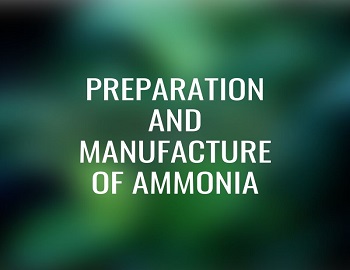Table of Contents
Preparation and Manufacture of Ammonia:
Preparation of Ammonia:
Ammonia is obtained by the following methods-
(1) By heating ammonium compounds, alone or with alkali.
| (NH4)2CO3 (Ammonium carbonate) ————-> 2NH3 ↑ + CO2 + H2O (NH4)2SO4 (Ammonium sulfate) ————-> NH3 ↑ + NH4HSO4 (Ammonium bisulfate) (NH4)2SO4 + 2NaOH ————-> 2NH3 + Na2SO4 + 2H2O |
(2) By action of water on metal nitrides, such as AlN and Mg3N2.
| AlN (Aluminium nitride) + 3H2O ————-> Al(OH)3 + NH3 ↑ Mg3N2 + 6H2O ————-> 3Mg(OH)2 + 2NH3 ↑ |
(3) By treatment of calcium cyanamide with steam under pressure.
| CaCN2 + 3H2O ————-> CaCO3 (Calcium carbonate) + 2NH3 ↑ |
Laboratory Preparation of Ammonia– Ammonia is prepared in the laboratory by heating an intimate mixture of ammonium chloride (NH4Cl) and slaked lime [Ca(OH)2].
The reaction involved is-
| 2NH4Cl + Ca(OH)2 ————-> 2NH3 ↑ + CaCl2 + 2H2O |

Method- Take an intimate mixture of ammonium chloride (1 part) and slaked lime (3 parts) in a hard glass tube with its mouth held downwards. Fit up the tube with a delivery tube which is connected to a tube containing quick lime (to remove moisture from the gas) and then to a gas jar.
Since ammonia is lighter than air and is highly soluble in water, it is usually collected by the downward displacement of air.
Drying of Ammonia Gas-Ammonia gas cannot be dried by passing it over concentrated sulfuric acid or fused calcium chloride as it reacts with them chemically. Thus, it is generally dried by passing the gas over quick lime or caustic soda sticks.
Manufacture of Ammonia:
Ammonia is usually prepared on a commercial scale from its elements hydrogen and nitrogen by Haber’s process. The reaction involved is-
| N2 + 3H2 ⇌ 2NH3 |
Haber’s Process: In this process, a mixture of N2 and H2 in the ratio of 1:3 by volume is compressed to 200-900 atmospheres. The compressed gaseous mixture is passed through soda lime in order to remove moisture and traces of carbon dioxide present in it. The dry, pure and compressed gaseous mixture is then passed over finely divided iron (as a catalyst) containing a little of molybdenum (as a promoter) maintained at 400-500°C in an electrically heated chamber. The outgoing gases containing ammonia so formed are then passed through a condenser when ammonia gets liquefied. The uncondensed gases are sent back to the compression pump by means of a recirculation pump. Herein, they are mixed with more of fresh gases and are then recirculated over the catalyst under pressure. The process is continued as usual.










Comments (No)